
Scarcity Principle: How to Create Demand Using Content Marketing
Knowing how to create demand for your products and services is often the difference between reaching your sales goals and a missed opportunity. One of the ways brands can reliably generate demand is through scarcity marketing tactics, which tap into people’s motivation to avoid loss or obtain something exclusive.
You are probably seeing scarcity marketing tactics all around you already without realizing it. Here we’ll take a look at some of the most effective ways to use them and examples from brands who are already doing it successfully.
Quick Takeaways:
- Scarcity marketing creates demand by playing on people’s fear of missing out or aversion to loss of a product or service.
- Emphasizing limited product availability, using time to create urgency, and highlighting demand with social proof are all scarcity tactics that motivate customers to act.
- Scarcity marketing tactics must be used in moderation and always be genuine — otherwise, brands risk losing trust or coming off as too aggressive.
The scarcity principle: what it is and why it works
We all want what we can’t have, right? By definition, scarcity marketing intentionally messages the limited availability or accessibility of a particular product. It plays on people’s fear of missing out (or FOMO as we all know it today).
Hubspot recently surveyed 300 general consumers to see how they felt about products in limited supply. The largest group (45%) reported that limited availability makes them more likely to learn more about or purchase a product.
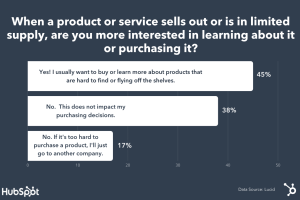
With scarcity marketing, you can tap into this natural desire that people have to obtain something right away in order to avoid the possibility of losing out on it later.
How to create demand using content marketing
Emphasize limited availability
You can create demand by emphasizing limited availability in your content — whether it’s due to low supply or to intentionally limited production.
When a product is already in high demand, telling your customers about it makes them want to jump on board (after all, if everyone else is buying a product, it must be awesome). Limited edition products (i.e. only a certain amount will be manufactured before it’s no longer available) have an air of exclusivity that motivates people to act quickly.
Low stock notices
Low stock notices are a fairly simple, easily-automated scarcity marketing tactic. They’re especially effective when paired with a personalization strategy. For instance, sending combined low stock and abandoned cart messages will remind a customer that a product they considered buying is now running low. This creates a new sense of urgency that will likely make them act.
Google keeps it simple and uses the tactic well in this abandoned cart email example:
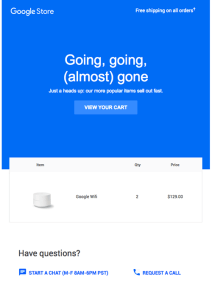
Amazon is another brand with a really effective low-stock notice strategy. Any time an item you look at is running low, you’ll see it in big font right on their product pages. If you were thinking about waiting until later to buy, that notification will likely make you reconsider.
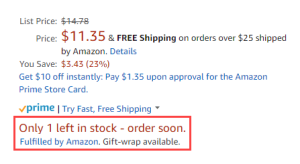
Limited or special edition items
It’s common for brands to create demand for products by intentionally limiting their production, making it more difficult to obtain it and again tapping into the motivation driven by exclusivity.
You’ll see this tactic used frequently by larger brands that can count on their established customer base to drive demand for their limited-edition products. Brands also add emotional connection to the equation by creating limited edition products around a particular event.
Coca-Cola does this often and well. A good example is their limited-edition packaging for every soccer world cup. The 2014 edition is up for sale on eBay 7 years later!
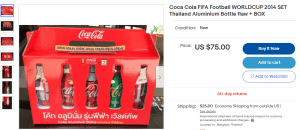
While it might be easier for a brand like Coke to implement this scarcity tactic at scale, it’s not impossible for smaller, independent brands to create limited edition products. The key is to know what’s important to your customer base.
Is there a particular event, cause, or initiative you can build a limited product around? If you sell unique and/or handmade goods created individually or in batches, your products are limited edition by nature. Are there other brands or creators you can partner with to create a special or unique product set? These are all effective ways to use this tactic.
Lean into the limited nature of your products in your content marketing, too, emphasizing why they’re unique (i.e. handmade, paired with a product from a partner brand) or important to your customer (for instance, when they’re connected to a meaningful event).
Create time limits
Setting a time limit on product availability creates a sense of urgency that is hard for customers to ignore. Whether it’s a sale you’re running for a defined period of time, a seasonal product, or an extra benefit that requires immediate action, leveraging time is an effective way to create demand. Let’s look at some examples.
Next day delivery timers
In today’s world, next-day delivery is nearly expected. Immediate gratification is everywhere, and customers are willing to take action in order to get their products sooner. Let’s revisit Amazon again. They use this tactic more effectively than any other brand. Search for a product and they highlight potential delivery times under every listing on the results page.

Click on a product, and Amazon will tell you exactly when you need to order the product to get same-day delivery. In this case, I could get my Echo Dot today if I order within 55 minutes. Even if my purchase isn’t urgent, odds are I’m going to order now just so I can receive it sooner.
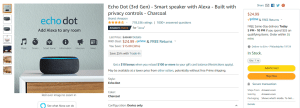
Limited time discounts
Discounts being run for a set period of time are a perfect opportunity to ramp up your content marketing to generate demand. Give your discount more visibility by creating an email campaign, sharing it on social media, and making it prominent on your website.
You can also get strategic about discounts to increase demand around a particular product. Everyone would prefer to pay less for a product they want, and discounts motivate people to act so they don’t miss out on a great deal.
Seasonal offerings
Seasonal offerings create demand because they’re novel. They also naturally create positive emotions by celebrating holidays and times of the year that people are excited about.
The coffee giants of the world do this really well. We see it every year when people get excited for Dunkin’ Donuts to start selling pumpkin spiced lattes every fall, or when Starbucks releases their special holiday cups.
Starbucks has done this so well over the years that there’s a dedicated fan page counting down the days until the red holiday cups come out.
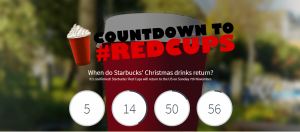
Seasonal offerings have an inherent scarcity built into them. Since you can only get them at a certain time of year, people want them when they’re available.
Highlight demand with social proof
One way to create the idea of scarcity is to highlight the existing high demand around a current product. If many people are already buying something, customers will feel more urgent about buying it themselves. So how do you highlight this existing demand? One of the most effective ways is to use tactics centered around social proof.
Showcase testimonials
Research shows that 93% of consumers today seek out reviews before they purchase a product. Most of them will trust the review even when it’s from a total stranger. You can utilize reviews and testimonials from satisfied customers by highlighting them on your website, social media, and product pages. This not only emphasizes the quality and value of your product; it tells your potential customers that it’s already in high demand.
Use hard numbers
One way to effectively highlight demand is to get right to the point by using hard numbers. Groupon does this really well. There’s already a high level of scarcity around Groupons offers — every deal has a limited quantity and set time limit. But Groupon also does a good job of showing which deals are especially popular by showing the exact number of purchases under every listing.

This tactic also uses social proof to create a virtuous demand cycle: the more purchases made, the higher the number, the bigger the social proof, the more purchases continue to be made. Talk about effective demand generation!
Show real-time activity
You can take the previous tactics to the next level by showing customers how many others are viewing the same product at that very moment. This is especially effective for products that have limited availability.
Etsy does this well. Many of their products are handmade and have limited quantities. When you look at a particular product, it shows you exactly how many others have it in their shopping cart. If customers know others are acting, they’re more likely to do it, too.

Scarcity marketing done right
It’s important to keep in mind that while scarcity marketing is a proven way to generate demand, it also has its pitfalls. Brands should always stick to genuine scarcity tactics and use them in moderation.
For example, continually insinuating that a product is in high demand when it isn’t will likely catch up to a brand. Once it does, customers will trust what they say a little less in the future. When scarcity marketing is used too much or the messaging is too aggressive, customers may be turned off by feeling pressured to make a purchase.
It’s a good idea to think holistically about when you want to use scarcity tactics to generate demand. Look at your overall demand marketing strategy and decide where it fits best with product launches, events, seasons, and other related factors.
Think also about ways it can be integrated into your regular promotions and content (for example, social proof content always showing on product pages). Plan ahead so that your messaging is always genuine and intentional.
Grow demand for your brand with awesome content
Are you ready to create consistent, high-quality content that grows your audience and converts customers? Marketing Insider Group can help you create a customized content calendar and deliver ready-to-publish content every week for a year (or more!).
Check out our Content Builder Service to learn more or schedule a quick consultation today!






